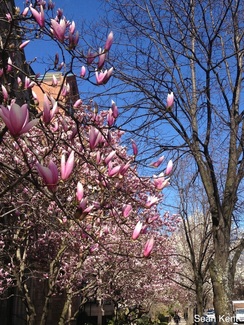"The bee buzz'd up in the heat...
For me, spring starts when one of the earliest flying bee emerges, the plasterer bee Colletes inaequalis (Colletidae). Colletes inaequalis are solitary, like all species in the genus Colletes, and nest in the ground, usually in aggregations. The pictures below of the Colletes female emerging from her nest was from an area where dozens of Colletes nests were in a meter squared and the entire nesting area was about the size of a basketball court. Enjoy the pictures of this great sign of spring. More pictures and info about Colletes inaequalis The magnolia trees were first planted by Laura Dwight in 1963. The Bee and The Flower by Alfred Tennyson
0 Comments
Leave a Reply. |
AuthorI am curious about nature and the wonderful species interactions I read about and see on a daily basis. Archives
November 2013
Categories
All
|


 RSS Feed
RSS Feed
